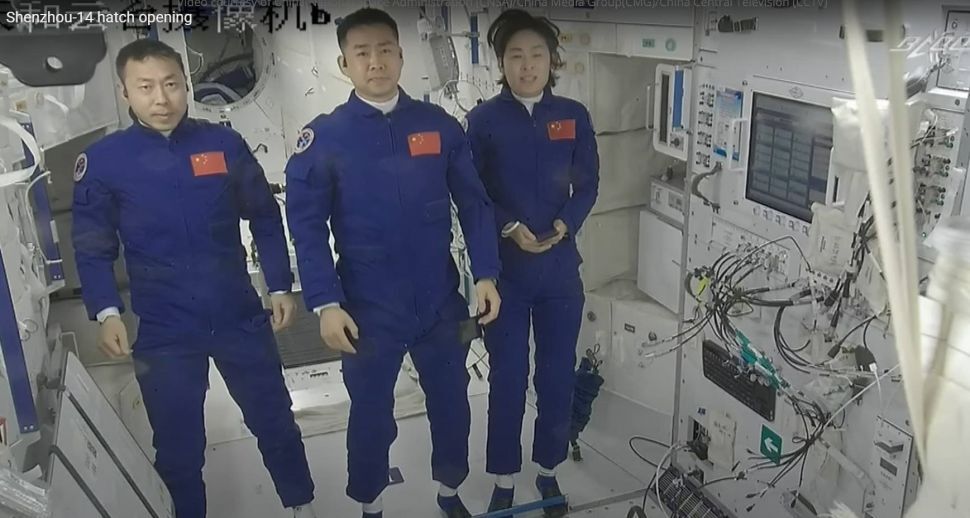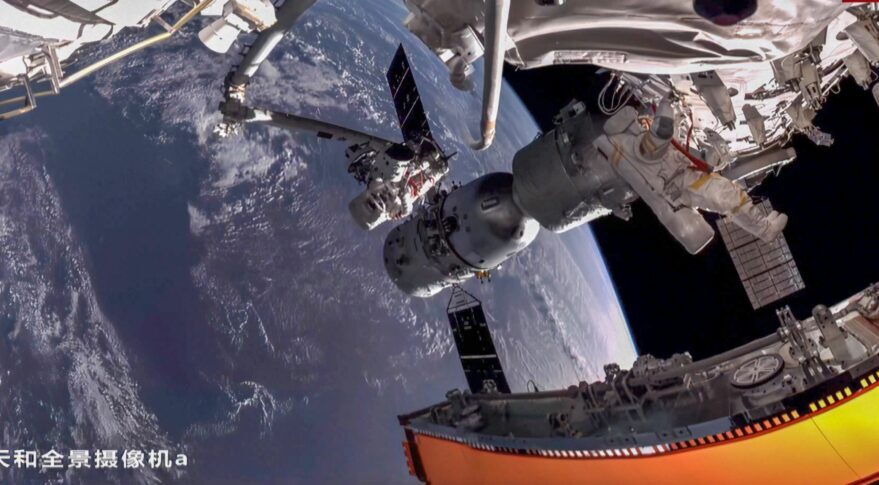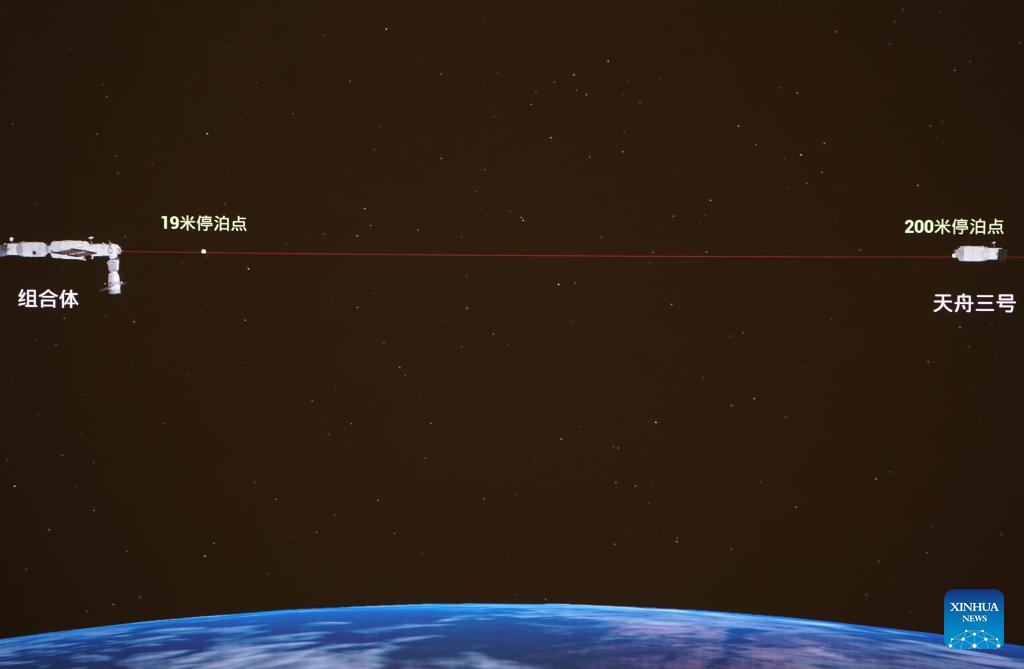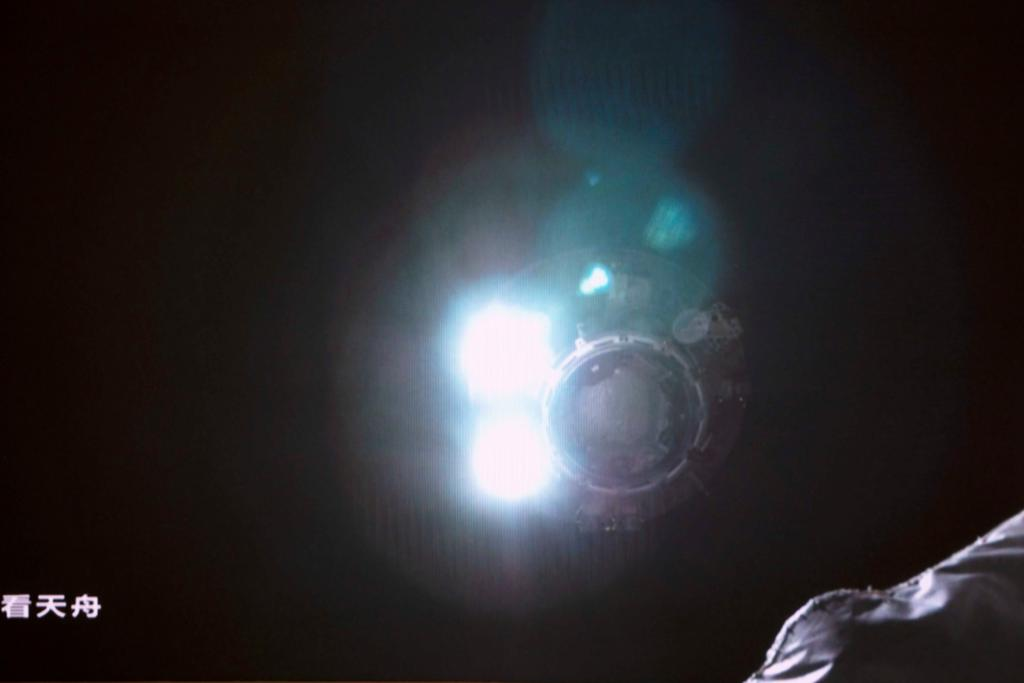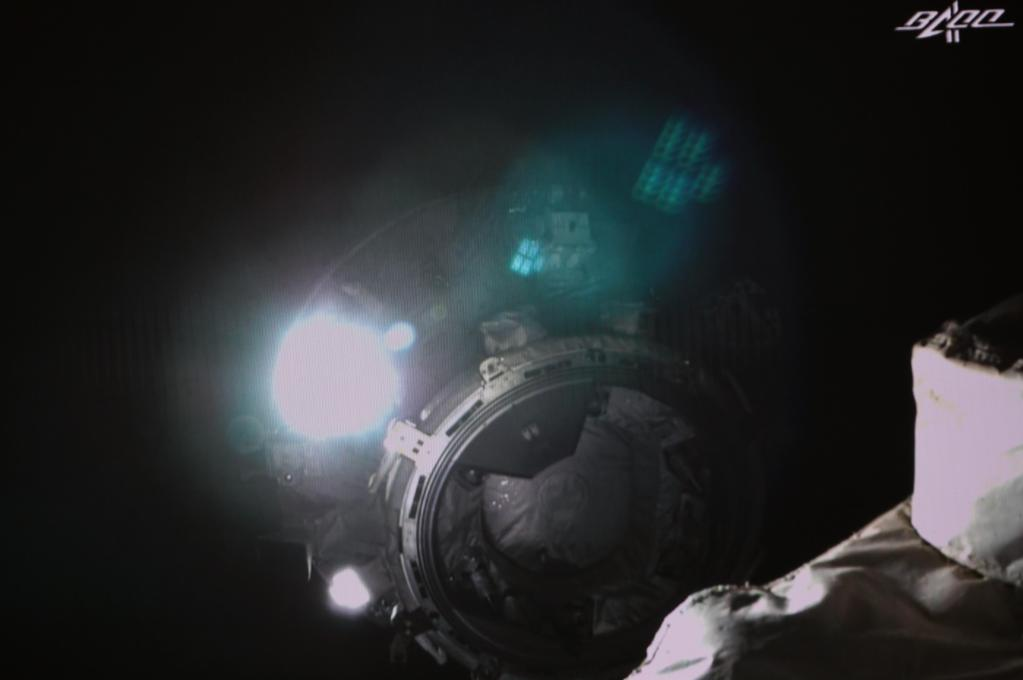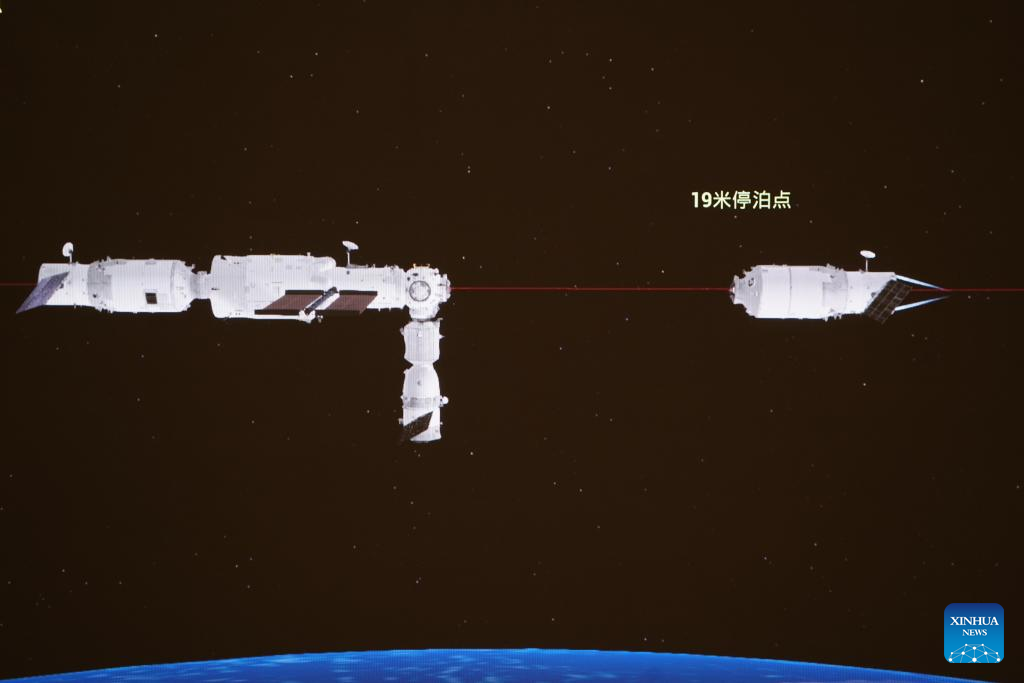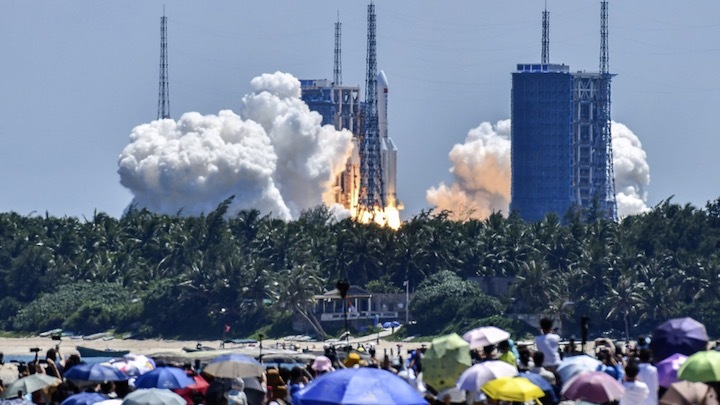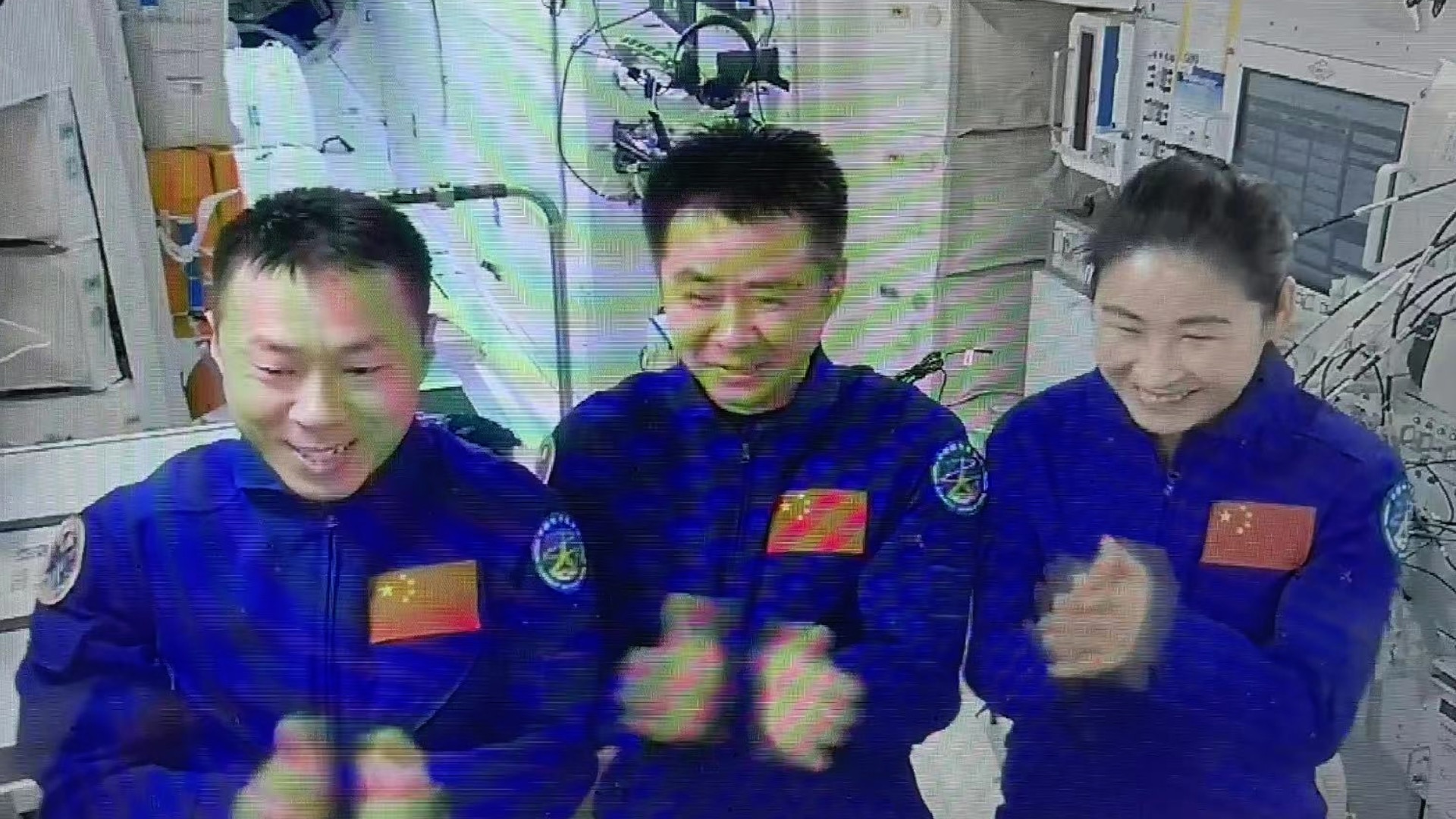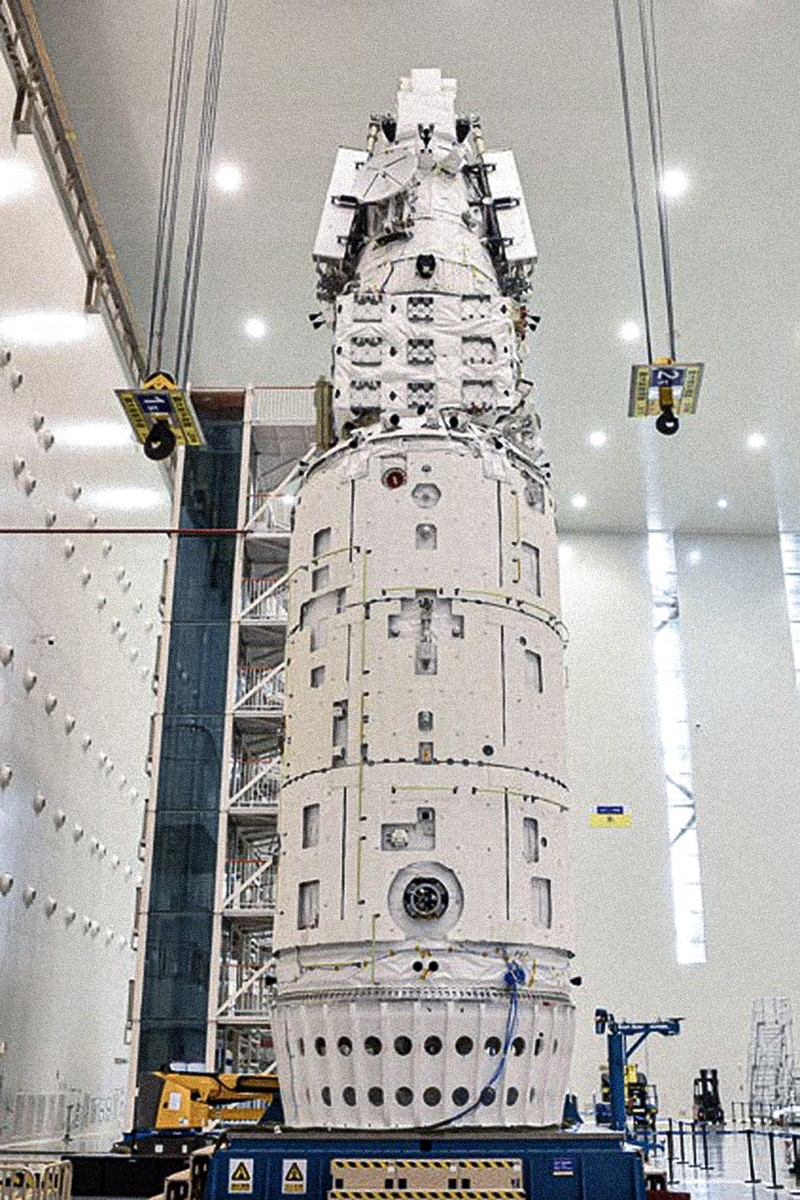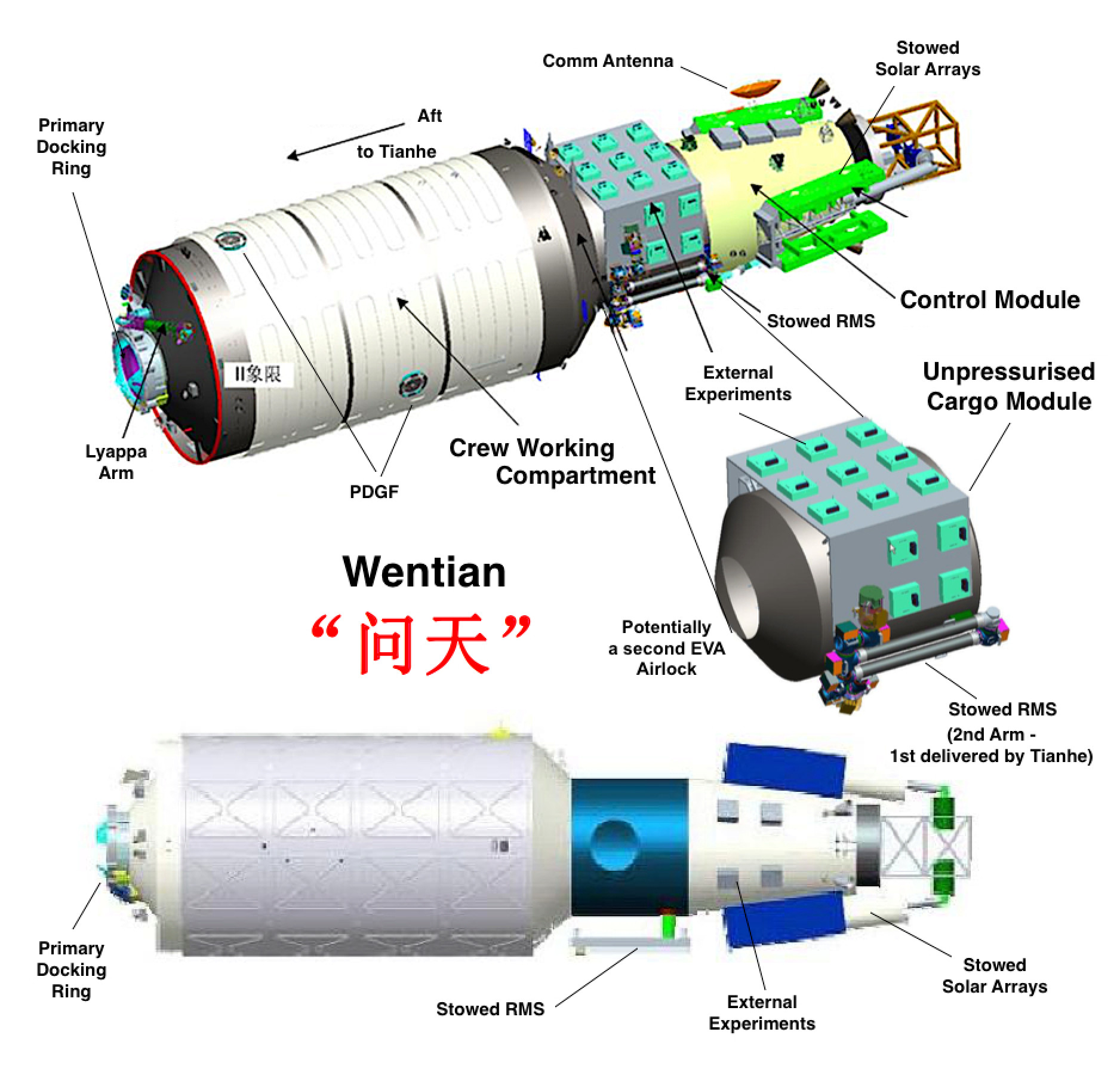5.06.2022
China plans to complete space station with latest mission
China is preparing to launch a new three-person mission to complete work on its permanent orbiting space station
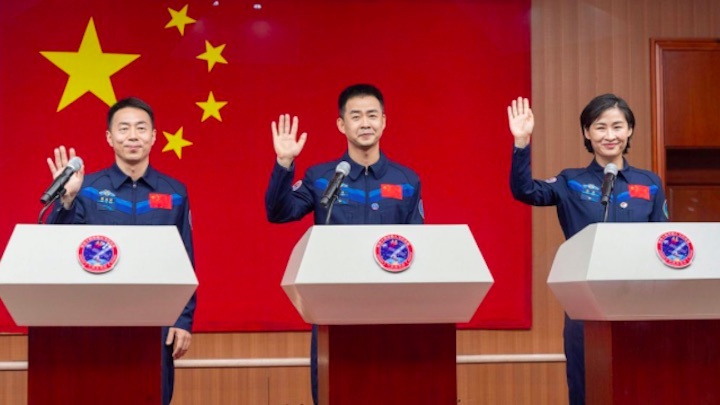
BEIJING -- China is preparing to launch a new three-person mission to complete work on its permanent orbiting space station, the China Manned Space Agency said Saturday.
The Shenzhou 14 crew will spend six months on the Tiangong station, during which they will oversee the addition of two laboratory modules to join the main Tianhe living space that was launched in April 2021.
Their spaceship is due to blast off from the Jiuquan Satellite Launch Center on the edge of the Gobi Desert at 10:44 a.m. Sunday (0244 GMT), the agency said. The crewed space flight program's workhorse Long March 2F rocket will provide propulsion.
Commander Chen Dong and fellow astronauts Liu Yang and Cai Xuzhe will assemble the three-module structure joining the existing Tianhe with Wentian and Mengtian, due to arrive in July and October. Another cargo craft, the Tianzhou-3, remains docked with the station.
The arrival of the new modules will “provide more stability, more powerful functions, more complete equipment,” said Chen, 43, who was a member of the Shenzhou 11 mission in 2016.
Liu, 43, is also a space veteran and was China's first female astronaut to reach space aboard the Shenzhou 9 mission in 2012. Cai, 46, is making his first space trip.
China’s space program launched its first astronaut into orbit in 2003, making it only the third country to do so on its own after the former Soviet Union and the U.S.
It has landed robot rovers on the moon and placed one on Mars last year. China has also returned lunar samples and officials have discussed a possible crewed mission to the moon.
China's space program is run by the ruling Communist Party's military wing, the People's Liberation Army, prompting the U.S. to exclude it from the International Space Station.
Chen, Liu and Cai will be joined at the end of their mission for three to five days by the crew of the upcoming Shenzhou 15, marking the first time the station will have had six people aboard.
Quelle: abcNews
+++
China discloses tasks of Shenzhou-14 crewed space mission
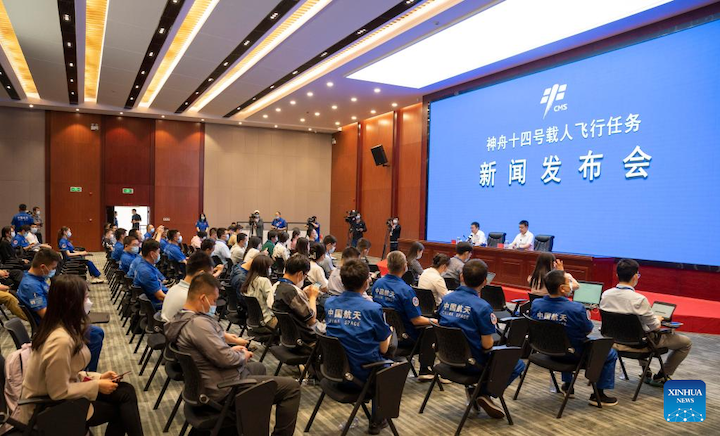
A press conference on the Shenzhou-14 crewed space mission is held at the Jiuquan Satellite Launch Center in northwest China, June 4, 2022. (Xinhua/Cai Yang)
The upcoming Shenzhou-14 crewed space mission will complete the construction of the Tiangong space station, with a basic three-module structure consisting of the core module Tianhe and the lab modules Wentian and Mengtian, according to the China Manned Space Agency (CMSA) on Saturday.
The mission will build the space station into a national space laboratory, said Lin Xiqiang, deputy director of the CMSA, at a press conference.
China is set to launch the Shenzhou-14 crewed spaceship on Sunday from the Jiuquan Satellite Launch Center, sending three astronauts to its space station combination for a six-month mission.
The Shenzhou-14 crew will work with the ground team to complete the rendezvous, docking and transposition of the two lab modules with the core module, Lin said.
They will enter the two lab modules for the first time and help make the environment suitable for their stay, he said, adding that they will unlock and install a dozen of scientific experiment cabinets in the two modules.
They will also carry out relevant function tests on the two-module space station complex, three-module space station complex, large and small mechanical arms, as well as exit from the airlock cabin in the Wentian lab module, with the assistance of the ground team.
The crew will, for the first time, use the airlock cabin in Wentian to carry out extravehicular activities for two to three times, Lin said.
They will continue to give "Tiangong Class" series to students for science popularization and perform other activities for public good.
The trio will also carry out in-orbit health monitoring, protective exercises, in-orbit training and drills, space station platform inspections and tests, equipment maintenance, as well as station and material management.
During their stay in orbit, the Shenzhou-14 crew will witness the two lab modules, Tianzhou-5 cargo craft and Shenzhou-15 crewed spaceship dock with the core module. They will experience nine space station complex configurations and conduct rendezvous and docking for five times.
The three astronauts will rotate with the Shenzhou-15 crew in orbit, before returning to the Dongfeng landing site in north China's Inner Mongolia Autonomous Region in December, Lin said.
Quelle: Xinhua
+++
China to launch Shenzhou-14 crewed spaceship on June 5
The Shenzhou-14 crewed spaceship will be launched at around 10:44 a.m. Sunday (Beijing Time) from the Jiuquan Satellite Launch Center in northwest China, announced the China Manned Space Agency (CMSA) on Saturday.
After entering orbit, the spaceship will adopt fast automated rendezvous and docking with the radial port of the space station core module Tianhe, forming a complex with Tianhe as well as the cargo spacecraft Tianzhou-3 and Tianzhou-4, said Lin Xiqiang, deputy director of the CMSA, at a press conference held at the launch center.
At present, the complex of Tianhe, Tianzhou-3 and Tianzhou-4 works in normal condition and is ready for rendezvous, docking and the astronauts' entry, Lin said.
The quality of both the Shenzhou-14 spaceship and the Long March-2F carrier rocket has been well checked. The crew is in good condition, and the ground system facilities are in stable operation, Lin said.
All preparations for the launch have been basically completed, Lin said.
Quelle: Xinhua
----
Update: 21:00 MESZ
.
China launches 3 astronauts to oversee construction of new Tiangong space station
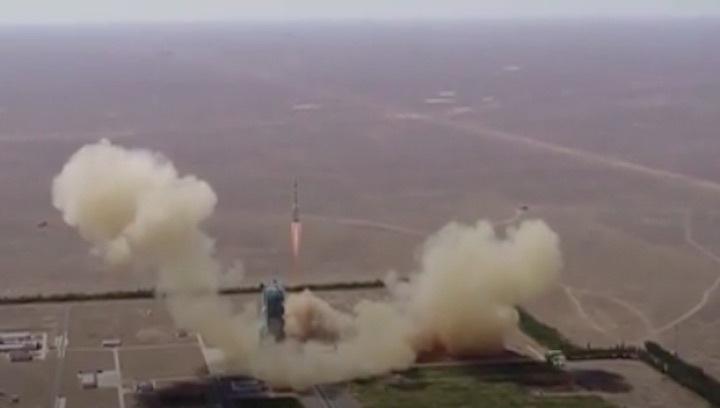
China has sent its third crew to the nation's new Tiangong space station.
A Long March 2F rocket carrying the Shenzhou 14 spacecraft lifted off from Jiuquan Satellite Launch Center in the Gobi Desert today (June 4) at 10:44 p.m. EDT (0244 GMT; 10:44 June 5 local time).
The three Shenzhou 14 crewmembers — commander Chen Dong, Liu Yang and Cai Xuzhe — were officially revealed as the crew earlier on Saturday. They are now heading for Tianhe, the core module of the still-under-construction Tiangong, with Shenzhou 14 expected to dock around six hours after launch.
The three spaceflyers are expected to spend six months aboard Tianhe. The 43-year-old Chen, a veteran of the 2016 Shenzhou 11 mission, is embarking on his second mission and first as commander. Liu, 43, became China's first woman in space aboard Shenzhou 9 in 2012 and is making her second flight, while Cai, 46, is making his first trip to space.
"The three of us are relatively young in terms of age," Chen told media at a press conference on Saturday. "But we are fully prepared, enthusiastic and confident. The Shenzhou 14 mission is key to the construction of the space station, with more difficulties and greater challenges."
All three crew members were selected in China's second astronaut selection round in 2010, meaning this is the first mission without one of China's older, first batch of astronauts along for the ride.
Awaiting the astronauts is Tianhe, the 54-foot-long (16.6 meters) space station core module that was launched in April 2021. It has so far been visited by a total of six astronauts, who made up the Shenzhou 12 and Shenzhou 13 crews.
The three new arrivals are tasked with overseeing the arrival of two new modules, named Wentian ("Quest for the Heavens") and Mengtian ("Dreaming of the Heavens"), which are due to launch in late July and October, respectively.
After the modules reach and dock with Tianhe, the crew, in cooperation with ground teams, will use Tianhe's large robotic arm to reposition the modules from the forward docking port to lateral ports.
The success of these missions would see the completion of the T-shaped Tiangong space station. The Shenzhou 14 trio are also expected to embark on spacewalks, engage in outreach activities, install new equipment both inside and outside the space station and conduct science experiments.
The Wentian module includes new crew quarters. So, if all goes according to plan, the Shenzhou 14 astronauts will welcome aboard the next trio of astronauts late in the year.
Shenzhou 15 is expected to launch in the December timeframe. Its arrival at Tiangong would see the first crew handover on the Chinese space station, with the orbital outpost hosting six astronauts for a few days.
China initiated its space station project back in 1992, first developing the ability to send humans to space and developing small test labs for short-term visits.
The completed Tiangong station is about 20% as massive as the International Space Station, according to Chinese space officials.
China last month launched the Tianzhou 4 cargo spacecraft to deliver thousands of pounds of supplies, propellant and science experiments to Tianhe to support the Shenzhou 14 mission.
Meanwhile, the Shenzhou 15 spacecraft and a Long March 2F rocket will be on standby at Jiuquan in case of an emergency affecting Shenzhou 14.
Quelle: SC
+++
Shenzhou-14 crewed mission arrives at Chinese space station
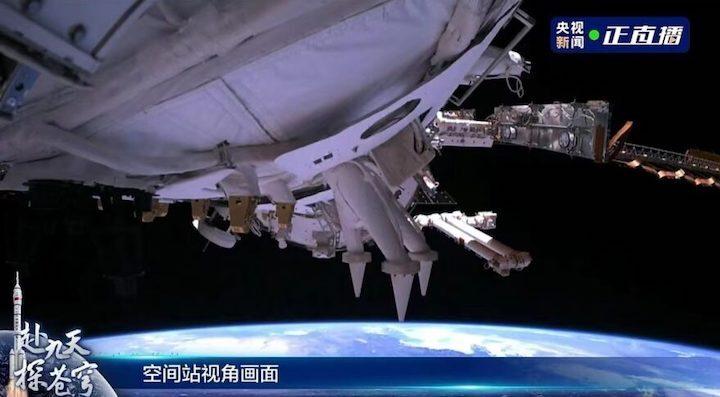
HELSINKI — China’s Shenzhou-14 crewed spacecraft docked with the Tianhe space station module early Sunday, marking the start of a crucial six-month-long mission.
Shenzhou-14 completed a fast automated rendezvous and docking with the Tianhe module at 5:42 a.m. Eastern, June 5, marking the safe arrival of astronauts Chen Dong (commander), Liu Yang and Cai Xuzhe.
The Long March 2F rocket carrying Shenzhou-14 and the three astronauts lifted off from the Jiuquan Satellite Launch Center at 10:44 p.m. Eastern Saturday. The spacecraft completed docking with the nadir, or Earth-facing, port of the Tianhe docking hub just under seven hours after launch from the Gobi Desert.
Also docked with the 16.6-meter-long, 4.2-meter-diameter Tianhe is the Tianzhou-4 cargo spacecraft, launched in May, containing supplies for the crew, along with propellant, science experiments and a number of CubeSats.
The Shenzhou-14 mission will, crucially, manage the arrival of two new 20-metric-ton-plus modules to the space station, namely Wentian and Mengtian, in July and October respectively.
“During the six months, we will be very busy,” Liu, who in 2012 became China’s first woman in space, said at a pre-launch press conference on Saturday. The astronauts were separated from the media by a screen, due to quarantine procedures.
“We will modify our space station from a single module into a three-module, three-spacecraft complex, during which three will be nine combination formations, five dockings, three departures and evacuations and two position changes.”
The missions will see the completion of the T-shaped, three-module Tiangong space station, a project initiated back in 1992.
Tianhe was launched in April 2021 and has so far hosted two crewed missions, Shenzhou-12 and Shenzhou-13, supported by the Tianzhou-2 and Tianzhou-3 logistics missions respectively.
“We will enter Wentian and Mentian lab modules for the first time,” Liu said. “We will conduct extravehicular activities with the aid of an airlock and robotic forearm, and carry out the combined operation of the [Tianhe] large arm and [Wentian] small arm.”
The crew will also complete a high number of scientific experiments and hold science outreach events, Liu added.
Chen, 43, first went to space on the month-long Shenzhou-11 mission to the Tiangong-2 test lab in 2016. Liu, 43, flew on Shenzhou-9 to visit Tiangong-1, while Cai, 46, is embarking on his first mission.
The new airlock cabin in Wentian will become the main exit-entry point for extravehicular activities (EVAs) once active. The Shenzhou-12 and Shenzhou-13 crews have so far used Tianhe’s docking hub for EVA entry and exit.
China’s first human spaceflight mission, Shenzhou-5, reached orbit in October 2003. Shenzhou-14 is only the ninth crewed mission launched by China in almost two decades, but the country is now committing to rolling six-month-long missions to the Tiangong space station for at least a decade.
Shenzhou-14 will handover to the Shenzhou-15 mission, expected to launch in December, when Tiangong will briefly host six astronauts for the first time.
Tiangong is designed to operate in orbit for at least ten years. It could be extended to six modules and host international astronauts.
China is also considering making the station available for tourist visits and will open Tiangong to commercial missions.
The country also plans to launch a co-orbiting optical telescope module, named Xuntian, in late 2023. It will be capable of docking with Tianhe for repairs, maintenance, refueling and upgrades, and aims to survey 40 percent of the sky across a decade.
Xuntian features a two-meter-diameter aperture and a field of view more than 300 times greater than the 32-year-old Hubble Space Telescope.
Russian officials have stated an interest in deeper human spaceflight cooperation with China while threatening to end its involvement in the International Space Station.
However, the 41.5 degree inclination of the Tiangong space station makes it very difficult for a Soyuz to launch to Tiangong from Russian territory, while ESA’s Kourou, which was being considered for hosting crewed Soyuz missions, is no longer available to Russia in the wake of its invasion of Ukraine.
Quelle: SN
----
Update: 8.06.2022
.
Successful launch of Shenzhou-14 draws worldwide attention
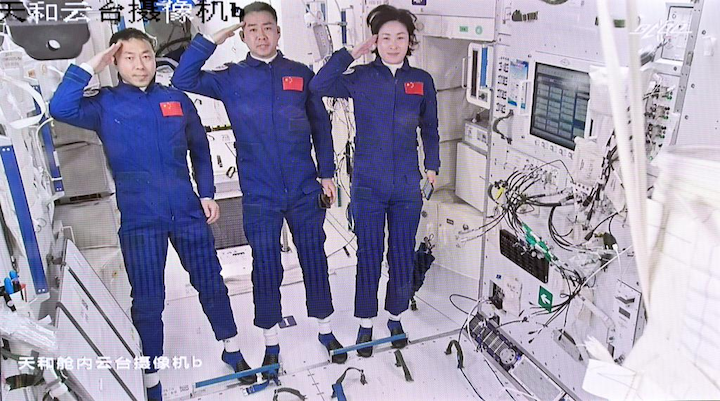
Screen image captured at Beijing Aerospace Control Center on June 5, 2022 shows three Chinese astronauts, Chen Dong (C), Liu Yang (R) and Cai Xuzhe, saluting after entering the space station core module Tianhe. (Xinhua/Li Xin)
The successful launch of the crewed spaceship Shenzhou-14 was reported by several international media outlets as worldwide observers called it a new step in China's efforts to complete its own space station and explore space.
On Sunday, three Chinese astronauts onboard the Shenzhou-14 spaceship were sent to space and entered the country's space station core module Tianhe. This is the 23rd flight mission since the approval and launch of the country's manned space program and the third crewed mission for China's space station project.
The flight of the Shenzhou-14 spacecraft to the Tiangong space station marked the beginning of a decade during which Chinese astronauts will constantly live and work in low-orbit Earth, Russia's Regnum news agency reported.
The Moscow Komsomolets newspaper detailed China's plans to build the Tiangong space station.
Noting that China has successfully sent another team of astronauts into space to complete its space station, Germany's DPA reported the space station underpins China's aspirations to catch up with the world's major manned spaceflight nations. China's space program has already achieved some successes, it added.
Croatian astronomer Ante Radonic said in an interview with Xinhua that the successful launch shows that China's manned spaceflight technology is mature and everything is going according to schedule.
The construction of China's space station would be completed soon, the astronomer said.
Noting that China is the third country in the world capable of independently carrying out manned spaceflight activities, Radonic said that China's manned spaceflight program already holds a leading position globally, and the space station program further demonstrates the rapid development of China's manned spaceflight technology.
South Korea's mainstream media, including Yonhap news agency and KBS, also reported on the launch.
China's space station has drawn wide attention, Yonhap news agency said, adding that if the International Space Station is decommissioned, China's Tiangong space station would be the world's only space station.
Quelle: Xinhua
+++
Shenzhou-14 astronauts enter Tianzhou-4 cargo craft
The Shenzhou-14 crew has entered the Tianzhou-4 cargo craft after finishing the environmental tests, according to the China Manned Space Agency (CMSA) on Monday.
After successfully stationing in China's space station core module Tianhe, the Shenzhou-14 crew opened the hatch of the Tianzhou-4 cargo craft and entered it at 12:19 p.m. (Beijing Time), the CMSA said.
The crew will also enter the Tianzhou-3 cargo craft, and carry out cargo transfer and other related work as planned.
The Shenzhou-14 spaceship was launched from the Jiuquan Satellite Launch Center in northwest China on Sunday.
The crew entered the core module Tianhe after Shenzhou-14 successfully completed a fast automated rendezvous and docking with the combination of the core module, the Tianzhou-3 cargo craft and the Tianzhou-4 cargo craft.
They will stay in orbit for six months and complete the assembly and construction of the space station.
Quelle: Xinhua
----
Update: 11.06.2022
.
Shenzhou-14 taikonauts to conduct 24 medical experiments in space
Taikonauts of the Shenzhou-14 crew will carry out 24 in-orbit medical experiments during their six-month stay in China's space station, according to the China Manned Space Agency on Thursday.
These space medical experiments are mainly designed to study how the weightless environment and spaceflights affect taikonauts, said Li Yinghui, deputy chief designer of China's manned space program taikonaut system.
Compared with previous crewed missions, the Shenzhou-14 will collect body fluid samples, including taikonauts' blood, urine, and saliva. The trio will also use non-invasive optical methods to measure muscle loss and analyze urine metabolites.
Li also noted that the body data collected by the previous Shenzhou-12 and Shenzhou-13 taikonauts has laid a good foundation for subsequent research by the Shenzhou-14 crew.
China on June 5 launched the three-person Shenzhou-14 mission, which is the third crew for the country's space station project. The taikonaut trio will cooperate with the ground team to complete the assembly and construction of the Tiangong space station. They will also work in its experiment cabinets for scientific exploration of life, ecology, and biotechnology.
Quelle: Xinhua
----
Update: 21.06.2022
.
China develops new coating for spacecraft thermal control
Chinese scientists have developed a metallic-based thermal-control coating for the Shenzhou-14 crewed spaceship that will protect the taikonauts from extreme heat and cold during their six-month stay in orbit.
The new coating works in two ways: providing low solar absorption to help reduce the sun's effect on the spacecraft's interior temperature; and providing low infrared emittance to block heat release from internal sources.
Tasked with completing the construction of China's Tiangong space station, the orbiting Shenzhou-14 taikonauts will witness several complex station configurations during their six-month journey. Cargo craft and lab modules that dock with the space station core module are likely to block the sunlight to the spaceship, resulting in long-term exposure to the extreme cold found in the shadows of deep space. The spaceship also has to cope with the intense heat found in the direct sunlight of outer space.
Without thermal controls, the temperature of the spacecraft's sun-facing side can soar to above 100 degrees Celsius, while the dark side can plunge to minus 100 degrees Celsius. The extreme high- and low-temperature environments pose challenges to the health of the taikonauts and the functioning of the spacecraft.
Developed by the China Academy of Space Technology, the thermal-control coating was first used on the Shenzhou-13 spacecraft, which was launched on Oct. 16, 2021. It kept the cabin environment within acceptable temperature ranges (between 18 and 26 degrees Celsius) during its six-month space journey, allowing the taikonauts to stay cool and comfortable in their orbiting home.
China launched the three-person Shenzhou-14 mission on June 5, providing the third crew for the country's space-station project. During their stay in orbit, the crew will witness two lab modules, the Tianzhou-5 cargo craft and Shenzhou-15 crewed spaceship docking with the space station core module.
Quelle: Xinhua
----
Update: 8.07.2022
.
China Focus: Shenzhou-14 taikonauts conduct in-orbit science experiments, prepare for space walks
Scientific endeavors aboard China's space station are expected to bear fruits, as the Shenzhou-14 taikonauts have devoted more time to microgravity experiments on the orbiting core module Tianhe since entering it a month ago.
China's space station is designed to be a versatile space lab, capable of accommodating 25 experiment cabinets for scientific exploration. The China Manned Space Agency has released video updates from space, which show that the station's core module is packed with research equipment, and the experiments in orbit span a range of disciplines, including microbiology, physics and medicine.
The three-member crew has conducted microbial tests in water, air and surface samples, aiming to ensure that they can stay safe and comfortable during the six-month spaceflight. They also installed a device for carbon dioxide reduction and regeneration in their orbiting home.
In the latest update, the trio was seen undergoing an eye examination and medical aid training.
Commander Chen Dong was spotted testing a spacesuit, preparing for the upcoming spacewalks out of the lab module Wentian, which is scheduled to be launched this month.
The experiment cabinets installed on Wentian will allow the taikonauts to perform experiments on molecules, cells, tissues and organs by using diverse online detection methods, such as visible light, fluorescence, or microscopic imaging.
However, it has not been all about the experiments and construction of the space station for the trio. They are also maintaining a decent work-life balance in orbit.
Recent videos captured them doing workouts on treadmills and exercise bikes to reduce the impact of microgravity exposure on the body.
Female taikonaut Liu Yang, donning a light pink waistcoat, was seen folding colorful paper stars for leisure and collecting them in a glass bottle. The video has drawn more than 1.2 million hits since China's space agency shared it on the microblogging site Sina Weibo on Tuesday.
Some media reports linked Liu's pastime activity to what she said before the mission --"write blessings to her children 'in the stars' during the space trip."
"Expecting her to bring back a bottle full of stars," commented a social media user.
Wu Dawei, deputy chief designer of China's manned space program taikonaut system, praised the Shenzhou-14 crew as "a young, lively and rigorous team with good physical, operational and psychological conditions."
China launched the Shenzhou-14 spaceship on June 5, sending three taikonauts Chen Dong, Liu Yang and Cai Xuzhe to its space station combination for a six-month mission. During their stay in orbit, the crew will witness two lab modules, the Tianzhou-5 cargo craft and Shenzhou-15 crewed spaceship, docking with the space station core module.
Quelle: Xinhua
----
Update: 11.07.2022
.

